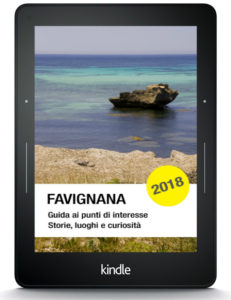This chapter belongs to the book “Favignana, a guide to places of interest” available on Amazon.
The eastern end of the island has a several metre-high coast, and approaching the sea is difficult. The best place, called Bue Marino (monk seal), is a descent to the sea among old tufa quarries. The water in front is dark blue with patches of amazing light blue. A man-made ledger of composite material allows people to plunge into the sea as from the edge of a swimming pool. Here, seawater is deep and you are immediately out of your depth, there is often a current and there is little shadow, but you can always take shelter in some cave in the quarries. The contrast and the nearness of the quarries and the crystal-clear sea make this particular place one of the most appreciated in the island.
To reach the Bue Marino from the village, you must follow the indications to Cala Rossa, then continue following those to Bue Marino. The road is less than 5 kilometres and the last stretch is a dirt road of tufa.
The name Bue Marino indicates that in the past here lived seals, and in particular the monk seal.
It is a good bay for dives and best when the wind blows from the west, but it is not advisable to go there with small children.
Once there, after a good bath, sitting on your towel, try to look at this place with different eyes and imagine how it was almost two centuries ago, on any day of the year. The quarries are bustling with quarrymen, you here the humming of their equipment on the tufa, some are working in underground passages for hours in the light of a candle, losing the sense of time, risking their lives and covering themselves with a heavy white dust. In the sea there are no tourists bathing, but other workers on the wooden boats with a lateen sail, called schifazzi. They get near the coast, call their mates on the island, who arrive with a cart loaded with tufa stones and pulled by a donkey. There is a lot of shouting, the boat is to be taken near the rocks and the tufa loaded into it through those stone-chutes: it is the final act of a piece-work. These pieces from Favignana go to Palermo, to Trapani, to Marsala, and also to Tunis.
So Favignana emptied to build houses and palaces elsewhere, and changed. What you see here at Bue Marino now is the result of man’s frenzied activity for over two centuries.



